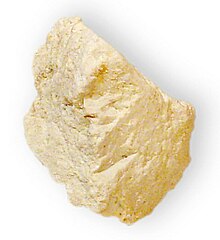Loading AI tools
Aluminosilicate clay mineral From Wikipedia, the free encyclopedia
Halloysite is an aluminosilicate clay mineral with the empirical formula Al2Si2O5(OH)4. Its main constituents are oxygen (55.78%), silicon (21.76%), aluminium (20.90%), and hydrogen (1.56%). It is a member of the kaolinite group. Halloysite typically forms by hydrothermal alteration of alumino-silicate minerals.[4] It can occur intermixed with dickite, kaolinite, montmorillonite and other clay minerals. X-ray diffraction studies are required for positive identification. It was first described in 1826, and subsequently named after, the Belgian geologist Omalius d'Halloy.
| Halloysite | |
|---|---|
 | |
| General | |
| Category | Phyllosilicates Kaolinite-serpentine group |
| Formula (repeating unit) | Al2Si2O5(OH)4 |
| Strunz classification | 9.ED.10 |
| Crystal system | Monoclinic |
| Crystal class | Domatic (m) (same H-M symbol) |
| Space group | Cc |
| Unit cell | a = 5.14, b = 8.9, c = 7.214 [Å]; β = 99.7°; Z = 1 |
| Identification | |
| Color | White; grey, green, blue, yellow, red from included impurities. |
| Crystal habit | Spherical clusters, massive |
| Cleavage | Probable on {001} |
| Fracture | Conchoidal |
| Mohs scale hardness | 2–2.5 |
| Luster | Pearly, waxy, or dull |
| Diaphaneity | Semitransparent |
| Specific gravity | 2–2.65 |
| Optical properties | Biaxial |
| Refractive index | nα = 1.553–1.565 nβ = 1.559–1.569 nγ = 1.560–1.570 |
| Birefringence | δ = 0.007 |
| References | [1][2][3] |
Halloysite naturally occurs as small cylinders (nanotubes) that have a wall thickness of 10–15 atomic aluminosilicate sheets, an outer diameter of 50–60 nm, an inner diameter of 12–15 nm, and a length of 0.5–10 μm.[5] Their outer surface is mostly composed of SiO2 and the inner surface of Al2O3, and hence those surfaces are oppositely charged.[6][7] Two common forms are found. When hydrated, the clay exhibits a 1 nm spacing of the layers, and when dehydrated (meta-halloysite), the spacing is 0.7 nm. The cation exchange capacity depends on the amount of hydration, as 2H2O has 5–10 meq/100 g, while 4H2O has 40–50 meq/100g.[8] Endellite is the alternative name for the Al2Si2O5(OH)4·2(H2O) structure.[8][9]
Owing to the layered structure of the halloysite, it has a large specific surface area, which can reach 117 m2/g.[10]


The formation of halloysite is due to hydrothermal alteration, and it is often found near carbonate rocks. For example, halloysite samples found in Wagon Wheel Gap, Colorado, United States are suspected to be the weathering product of rhyolite by downward moving waters.[4] In general the formation of clay minerals is highly favoured in tropical and sub-tropical climates due to the immense amounts of water flow. Halloysite has also been found overlaying basaltic rock, showing no gradual changes from rock to mineral formation.[11] Halloysite occurs primarily in recently exposed volcanic-derived soils, but it also forms from primary minerals in tropical soils or pre-glacially weathered materials.[12] Igneous rocks, especially glassy basaltic rocks are more susceptible to weathering and alteration forming halloysite.
Often as is the case with halloysite found in Juab County, Utah, United States the clay is found in close association with goethite and limonite and often interspersed with alunite. Feldspars are also subject to decomposition by water saturated with carbon dioxide. When feldspar occurs near the surface of lava flows, the CO2 concentration is high, and reaction rates are rapid. With increasing depth, the leaching solutions become saturated with silica, aluminium, sodium, and calcium. Once the solutions are depleted of CO2 they precipitate as secondary minerals. The decomposition is dependent on the flow of water. In the case that halloysite is formed from plagioclase it will not pass through intermediate stages.[4]
A highly refined halloysite is mined, then processed, from a rhyolite occurrence in Matauri Bay, New Zealand.[13][14][15][16] Annual output of this mine is up to 20,000 tonnes per annum.[17]
One of the largest halloysite deposits in the world is Dunino, near Legnica in Poland.[18] It has reserves estimated at 10 million tons of material. This halloysite is characterized by layered-tubular and platy structure.[19]
The Dragon mine, located in the Tintic district, Eureka, Utah, US deposit contains catalytic quality halloysite. The Dragon Mine Deposit is one of the largest in the United States. The total production throughout 1931–1962 resulted in nearly 750,000 metric tons of extracted halloysite. Pure halloysite classified at 10a and 7a are present.[20]
Commercial
Uses of the halloysite produced at the Matauri Bay deposit in New Zealand include porcelain and bone china by manufacturers in various countries, particularly in Asia.[13][14][15][16]
Laboratory studies
Typical chemical and mineralogical analyses of two commercial grades of halloysite are:[32]
| Product name | Premium | Yunnan |
|---|---|---|
| Country | New Zealand | China |
| Area | Northland | Yunnan |
| SiO2, % | 49.5 | 42.7 |
| Al2O3, % | 35.5 | 37.0 |
| Fe2O3, % | 0.29 | 0.10 |
| TiO2, % | 0.09 | <0.05 |
| CaO, % | - | - |
| MgO, % | - | - |
| K2O, % | - | <0.05 |
| Na2O, % | - | <0.05 |
| LOI, % | 13.8 | 19.8 |
| Halloysite, % | 92 | 99.1 |
| Cristobalite, % | 4 | - |
| Quartz, % | 1 | 0.1 |
Seamless Wikipedia browsing. On steroids.
Every time you click a link to Wikipedia, Wiktionary or Wikiquote in your browser's search results, it will show the modern Wikiwand interface.
Wikiwand extension is a five stars, simple, with minimum permission required to keep your browsing private, safe and transparent.